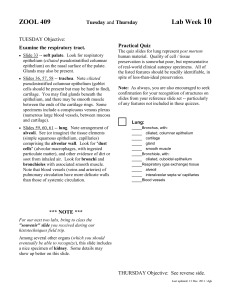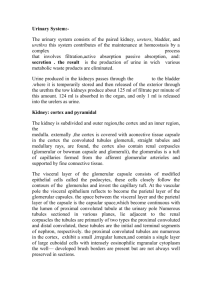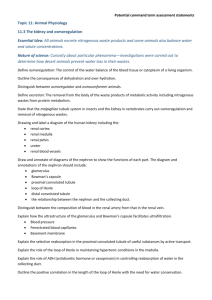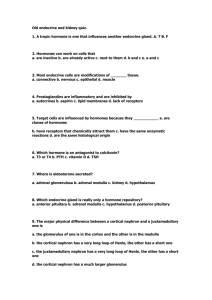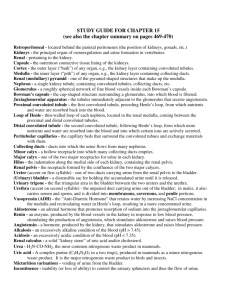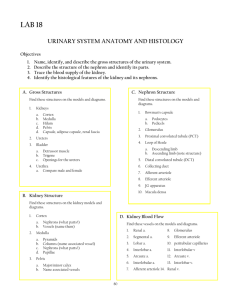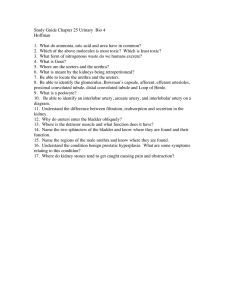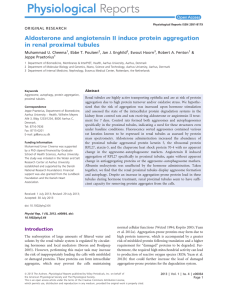11 ZOOL 409 Lab Week Tuesday
advertisement
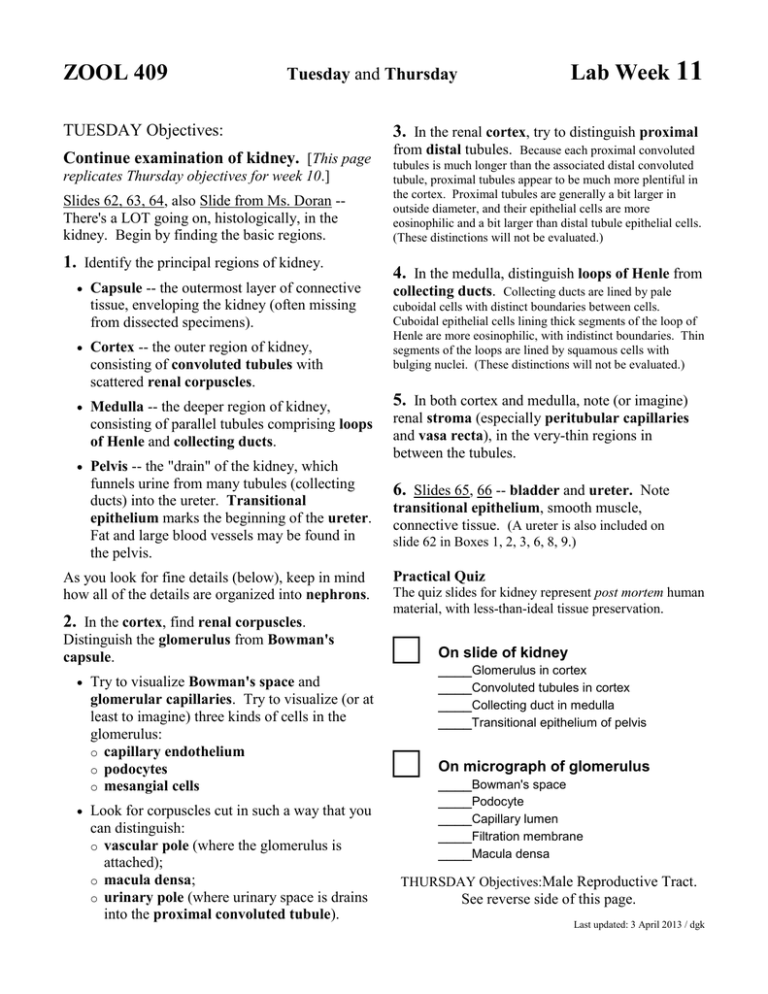
ZOOL 409 TUESDAY Objectives: Continue examination of kidney. [This page replicates Thursday objectives for week 10.] Slides 62, 63, 64, also Slide from Ms. Doran -There's a LOT going on, histologically, in the kidney. Begin by finding the basic regions. 1. Identify the principal regions of kidney. Capsule -- the outermost layer of connective tissue, enveloping the kidney (often missing from dissected specimens). Cortex -- the outer region of kidney, consisting of convoluted tubules with scattered renal corpuscles. Medulla -- the deeper region of kidney, consisting of parallel tubules comprising loops of Henle and collecting ducts. Pelvis -- the "drain" of the kidney, which funnels urine from many tubules (collecting ducts) into the ureter. Transitional epithelium marks the beginning of the ureter. Fat and large blood vessels may be found in the pelvis. As you look for fine details (below), keep in mind how all of the details are organized into nephrons. 2. In the cortex, find renal corpuscles. Distinguish the glomerulus from Bowman's capsule. Lab Week 11 Tuesday and Thursday Try to visualize Bowman's space and glomerular capillaries. Try to visualize (or at least to imagine) three kinds of cells in the glomerulus: o capillary endothelium o podocytes o mesangial cells Look for corpuscles cut in such a way that you can distinguish: o vascular pole (where the glomerulus is attached); o macula densa; o urinary pole (where urinary space is drains into the proximal convoluted tubule). 3. In the renal cortex, try to distinguish proximal from distal tubules. Because each proximal convoluted tubules is much longer than the associated distal convoluted tubule, proximal tubules appear to be much more plentiful in the cortex. Proximal tubules are generally a bit larger in outside diameter, and their epithelial cells are more eosinophilic and a bit larger than distal tubule epithelial cells. (These distinctions will not be evaluated.) 4. In the medulla, distinguish loops of Henle from collecting ducts. Collecting ducts are lined by pale cuboidal cells with distinct boundaries between cells. Cuboidal epithelial cells lining thick segments of the loop of Henle are more eosinophilic, with indistinct boundaries. Thin segments of the loops are lined by squamous cells with bulging nuclei. (These distinctions will not be evaluated.) 5. In both cortex and medulla, note (or imagine) renal stroma (especially peritubular capillaries and vasa recta), in the very-thin regions in between the tubules. 6. Slides 65, 66 -- bladder and ureter. Note transitional epithelium, smooth muscle, connective tissue. (A ureter is also included on slide 62 in Boxes 1, 2, 3, 6, 8, 9.) Practical Quiz The quiz slides for kidney represent post mortem human material, with less-than-ideal tissue preservation. □ □ On slide of kidney ____Glomerulus in cortex ____Convoluted tubules in cortex ____Collecting duct in medulla ____Transitional epithelium of pelvis On micrograph of glomerulus ____Bowman's space ____Podocyte ____Capillary lumen ____Filtration membrane ____Macula densa THURSDAY Objectives:Male Reproductive Tract. See reverse side of this page. Last updated: 3 April 2013 / dgk ZOOL 409 Lab Week 11 Tuesday and Thursday TUESDAY Objectives: See reverse side. THURSDAY Objectives: Examine male reproductive tract. 1. Slide 67, 68 -- Testis. Understand basic tissue organization of this organ -- many seminiferous tubules lined by columnar epithelium. Distinguish Sertoli cells from germ-line cells. Try to distinguish (or imagine) different stages in meiosis and sperm maturation. Note Leydig cells in testicular stroma. 2. Slide 68 -- Epididymis. Understand basic tissue organization of this organ: one long, highly coiled tubule, lined by pseudostratified columnar epithelium, with some smooth muscle in the wall. Look for sperm cells in the lumen of the tubule. Practical Quiz The quiz slides for male tract represent post mortem human material, with less-than-ideal tissue preservation, especially where epithelial cells are unattached. Many details are nevertheless recognizable. □ □ The seminal vesicle has the appearance of several large sacs with very convoluted mucosal lining. Try to distinguish smooth muscle in the wall of gland. Slide 2 is preadolescent. ____Seminiferous tubules (simple columnar epithelium, without spermatogenesis) ____Rete testis ____Epididymis 3. Slide 70 -- Seminal vesicle. Slide 1: What organ? ____Capsule ____Blood vessel in stroma □ Slide 3: What organ? ____Epithelium ____Smooth muscle 4. Slide 71 -- Prostate. Note irregular shape of glandular epithelium. Unlike most other exocrine glands, the prostate does not have tidy acinar or tubular organization. Try to detect smooth muscle throughout the glandular stroma.. Look for prostatic concretions (corpora amylacea) in glandular lumens. □ □ Slide 4: What organ? ____Secretory epithelium ____Fibromuscular stroma Slide 5: Find the vas. (Most of specimen is bladder wall.) Last updated: 13 Dec. 2011 / dgk
